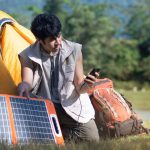

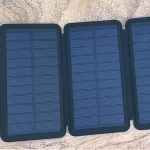
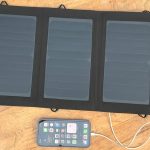
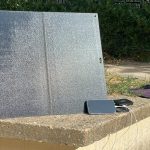
NEWS
Solar chargers
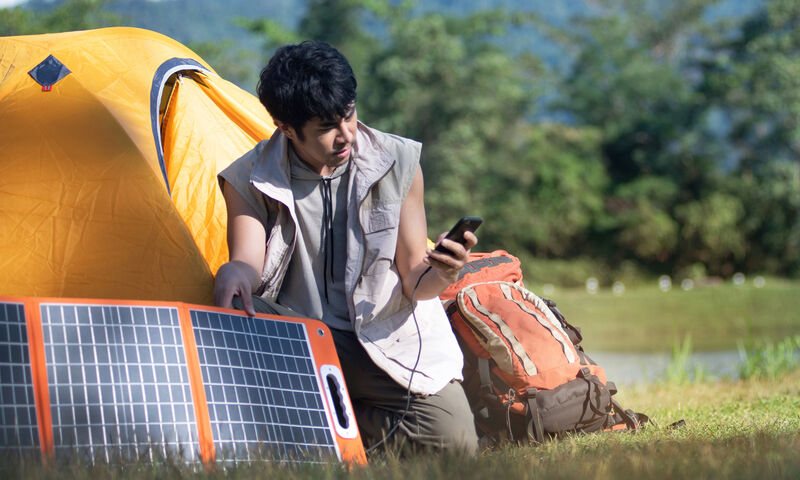
© chomplearn_2001/Stock.Adobe
What if small photovoltaic panels allowed us to recharge our daily devices simply and for free? We bought and tried different portable solar chargers to see if they are really useful. Here are our first impressions.
As electricity prices skyrocket and we all look to reduce our impact on the environment, solar energy is catching everyone’s attention. The installation of photovoltaic panels makes it possible to collect solar energy to heat a house or produce electricity. On a smaller scale, this energy can also recharge our small daily devices, smartphones, touchscreen tablets or even connected watches, particularly during outdoor activities.
There are different models of solar chargers, from the very small panel integrated into an external battery to the larger foldable and transportable panel. Knowing that they require a certain budget (between €60 and €170) and that the power of a photovoltaic panel depends in particular on its surface area, we wanted to know if these different solutions were really useful. We therefore bought and tried a few models to get an idea, without claiming to be exhaustive. Clarification: we carried out our tests in summer, the sunniest time of the year, also the most conducive to the use of these chargers which are intended to be used during outdoor activities.
Foldable and portable solar charger
Powertec Pocket Power 6.5W (€129.90)
This small panel made up of 4 panels takes up no more space than a paperback book. It promises to recharge a smartphone, an external battery or even a camera in a few hours. Devices charge as soon as they are connected (cables not included): the Powertec offers live charging, solar energy is transformed into electricity in real time. Hikers will appreciate the reassuring dimension of the solution, which allows them to go for a walk without fear of running out of smartphone. However, it is important to note that some devices do not support charging when the charger’s output power is not stable. However, on a solar panel, the voltage can drop during a cloudy period, which precisely makes the power unstable. In this case, you can always recharge an external battery which will be used to recharge the devices.
The sunny days of June allowed us to recharge 30% of the battery of an iPhone 13 Pro in 4 hours. Do not compare with the 3 hours 15 minutes measured in the laboratory for a full charge with a conventional mains charger! This Powertec fulfills its role as an emergency charger well.
The manufacturer offers other models, in various formats and offering different powers (€100 to €350).
Solar panel portable battery
Elzle Solar Charger (€59)
This model is above all an external battery, which incorporates a photovoltaic panel to be considered as an additional means of charging the battery. This 4-panel panel can also provide continuous energy to recharge a device. The integrated lamp is, with the solar panel, proof that Elzle intends its battery for backpackers (even if a real lamp, headlamp or pocket, is an essential piece of hiking equipment). In addition, the announced capacity is 26,800 mAh, which allows several devices to be recharged comfortably (smartphone, tablet, and even laptop PC). But don’t expect to quickly charge a battery of this capacity… We only filled one LED indicator out of the 5 in 7.5 hours of non-stop solar charging, which means we only regained 20 % capacity at most. This confirms that solar panels are only there to deal with an emergency; It is better to go for a walk after having fully charged the battery from the mains.
USB solar panel
Forclaz SLR900 15W (€60)
The Forclaz SLR900 solar panel (Decathlon) has a power of 15 W. The manufacturer does not recommend using this foldable panel as a continuous energy source to power a smartphone; Instead, he recommends recharging an external battery that will be used to charge your devices. Because clouds, or even shadows, make the output power unstable due to voltage drops. However, not all devices are protected against these electrical bursts.
More powerful than the Powertec, lighter than the Elzle external battery, this panel offers dimensions that still allow it to be easily slipped into a bag during outdoor activities (52 x 29 cm unfolded, 17 x 29 cm folded, 430 g) . Delivered with two carabiners, its perimeter is also lined with small fabric loops: Decathlon invites you to hang the SLR900 from a bag, a table or any other support. In terms of performance, the manufacturer indicates a charging time of 5 hours for a 10,000 mAh battery in direct sunlight and 10 hours if there are clouds. Allow 3 hours and 6 hours respectively for a 5,000 mAh battery.
Mobile solar panel
Quechua 50W solar panel for camping (€150)
The reference sets the tone: this time, the solar panel is made for camping. At 55 cm high, 62 cm wide (open) and 2.2 kg, there’s no question of carrying it for hours! This bulk is the counterpart of greater power. This 50 W Quechua model can charge several devices simultaneously. It comes with a box which has 3 USB ports and which regulates the power delivered. You can directly connect a smartphone, a tablet, a camera or wireless headphones without worrying that electrical bursts will slow down the charging.
With this power, we move into another dimension. This is no longer an emergency solution to compensate for a battery failure, but rather a credible alternative to mains chargers for everyday devices, subject to mild weather. A large solar panel allows you to consider autonomy, which is even more necessary in the great outdoors. The only constraint: not going too far from the panel, which still costs €150.
What you need to know about solar chargers
Efficiency
The efficiency of a solar panel depends a lot on the sunlight conditions. Elevation, time of year, angle and position relative to the sun also play a role. Remember to orient and move your panel according to the movement of the sun during the day.
Yield
There are different qualities of photovoltaic cells. Some react better than others to high temperatures. And they display different efficiencies, that is to say the quantity of solar energy transformed into electricity compared to the total stored. This efficiency ranges from 10-12% for the worst panels to 20-25% for the best. Manufacturers provide information on packaging. This efficiency directly impacts the charging time!
Power (W)
The power mentioned corresponds to the electrical power produced under ideal conditions. At high power, superior charging comfort.
Stabilized power
The panels are sensitive to light; a cloud that obscures the sun can cause power variations. In this case, it is possible that a smartphone or tablet refuses to charge, because some devices require a fixed intensity. However, there is no risk of damaging them.
Load curve
With lithium batteries, charging is more effective when the battery is empty. This is true with a mains charger, but also with a solar charger! So, for example, your smartphone battery will go from 0 to 50% faster than from 80 to 100%.

Author Bio
A connoisseur of the digital marketplace and a master of the written word, this 30-year-old English expert brings to the table a wealth of knowledge rooted in the sale of digital products and a passion for blogging that resonates with an audience seeking expertise and insight in the online realm.
Their insights are drawn from hands-on experience navigating the intricacies of e-commerce and content creation—leading the forefront of digital innovation and communication. Whether it’s breaking down complex marketing strategies or sharing tips on how to captivate an online audience, their work stands as a testament to a career built upon successful digital engagement and savvy business acumen.
Stay tuned to absorb compelling content from a voice that not only understands the digital landscape but also shapes its future through every blog post and digital strategy.
